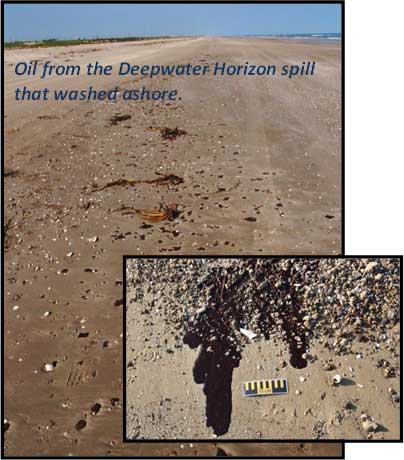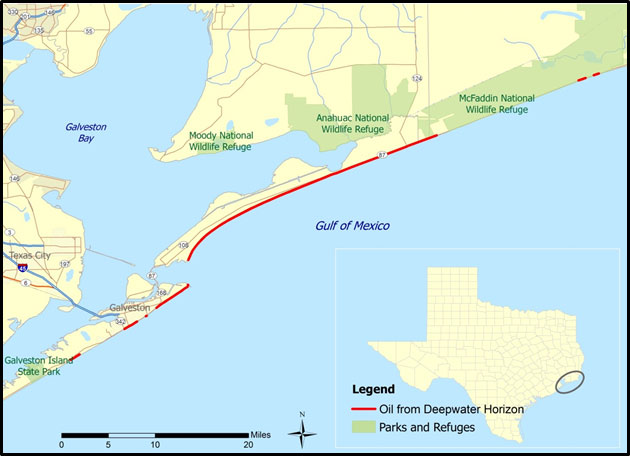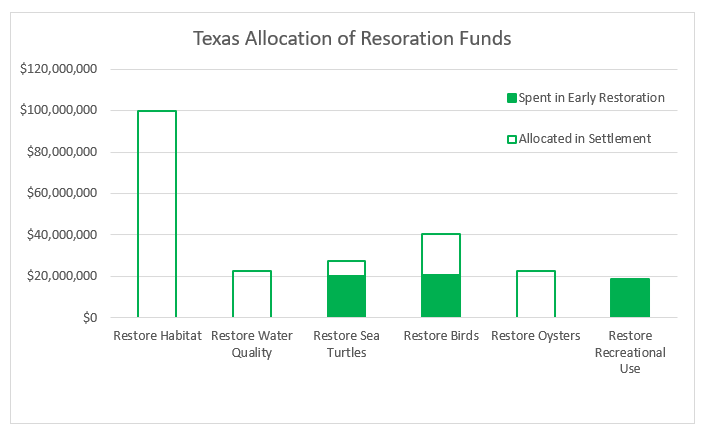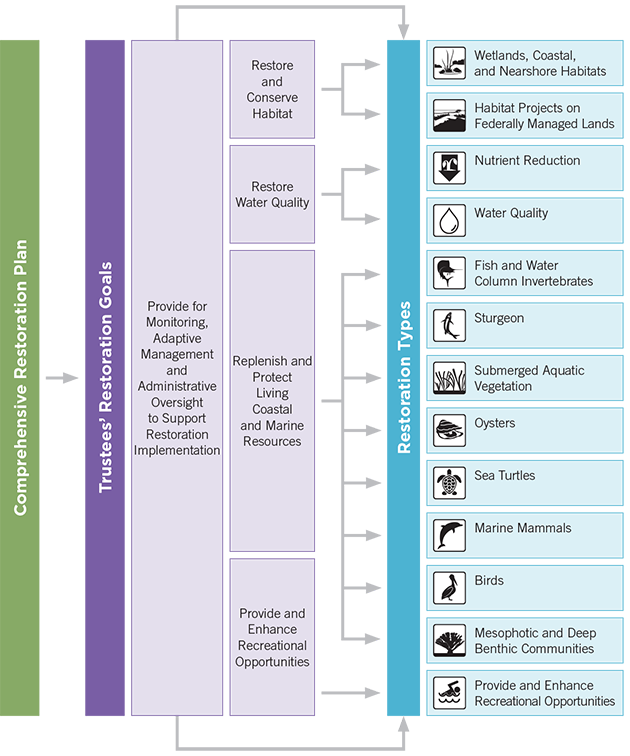- Texas media inquiries: Julie Hagen, (512) 389-4620
- Texas Trustee inquiries email
Deepwater Horizon Oil Spill
Background Information
 On April 20, 2010, BP Exploration and Production Inc. (BP) was using Transocean's mobile offshore drilling unit Deepwater Horizon to drill a well in the Macondo prospect (Mississippi Canyon 252–MC252) when the well blew out. The drilling unit exploded and caught fire, resulting in the death of 11 workers. Two days later, the platform sank releasing millions of barrels of crude oil into the Gulf of Mexico over a period of 87 days. In addition, over 1 million gallons of dispersants were applied to the waters of the spill area in an attempt to disperse the oil. An undetermined amount of natural gas was also released to the environment as a result of the spill. The oil spill, along with associated removal activities, adversely affected and injured natural resources within the jurisdictions of the United States and the States of Texas, Louisiana, Mississippi, Alabama, and Florida and resulted in lost recreational uses of those resources. Texas suffered from both direct (e.g. direct oiling on beaches and wildlife) and indirect impacts (e.g. decreased recreational use; damaged habitat which in turn negatively impacted wildlife populations) as a result of the spill.
On April 20, 2010, BP Exploration and Production Inc. (BP) was using Transocean's mobile offshore drilling unit Deepwater Horizon to drill a well in the Macondo prospect (Mississippi Canyon 252–MC252) when the well blew out. The drilling unit exploded and caught fire, resulting in the death of 11 workers. Two days later, the platform sank releasing millions of barrels of crude oil into the Gulf of Mexico over a period of 87 days. In addition, over 1 million gallons of dispersants were applied to the waters of the spill area in an attempt to disperse the oil. An undetermined amount of natural gas was also released to the environment as a result of the spill. The oil spill, along with associated removal activities, adversely affected and injured natural resources within the jurisdictions of the United States and the States of Texas, Louisiana, Mississippi, Alabama, and Florida and resulted in lost recreational uses of those resources. Texas suffered from both direct (e.g. direct oiling on beaches and wildlife) and indirect impacts (e.g. decreased recreational use; damaged habitat which in turn negatively impacted wildlife populations) as a result of the spill.

Above is a map displaying information regarding the location of oil that was observed on the Texas shoreline.
Early Restoration
After the Deepwater Horizon oil spill, federal and state agencies came together to form the Deepwater Horizon Natural Resource Damage Assessment (NRDA)Trustees Council. The Council studied the effects of the oil spill and began restoring the environment through Early Restoration. Early restoration projects represent an initial step toward fulfilling the responsible parties’ obligation to pay for restoration of injured natural resources, as well as the loss of human use of Gulf resources.
Under the early restoration agreement signed by BP (a responsible party) and the Trustees, BP committed to provide $1 billion toward implementation of early restoration projects. BP agreed to fund projects jointly agreed to by BP and the Trustees, after the public was given the opportunity to comment. The broad scope of the impacts to natural resources resulted in a complex negotiation process for the identification and selection of early restoration projects. Phases III and IV of Early Restoration included projects that were implemented in Texas or by the Texas Trustees.
Settlement with BP and Plan to Restore the Gulf
A federal district court in New Orleans entered a consent decree resolving civil claims against BP arising from the April 20, 2010 Macondo well blowout and the massive oil spill that followed in the Gulf of Mexico.
Under this settlement, BP has agreed to pay the Trustees for Deepwater Horizon Natural Resource Damage Assessment up to $8.8 billion for restoration over 15 years to address natural resource injuries. This includes $238 million for Texas restoration efforts. The chart and table below show the restoration funding allocated to the Texas Restoration Area for each restoration goal. Note that some restoration categories have been fully addressed in Early Restoration; the remaining restoration funds will be allocated over the next 15 years. For more information on the allocation of funds, please visit the Gulf Spill Restoration website.

The Trustees finalized the Programmatic Damage Assessment and Restoration Plan and Programmatic Environmental Impact Statement (PDARP/PEIS) in February 2016. The plan identifies the types of restoration needed to compensate the public for impacts to natural resources that resulted from the oil spill. The Plan identifies five goals intended to restore wildlife, habitat, water quality, and recreational activities in the Gulf. To achieve these goals, funds are allocated to 13 different restoration types. The restoration types address a broad range of impacts at both regional and local scales. The implementation of The Plan will restore wildlife and habitat and associated services such as recreational opportunities that were impacted by the spill.
The Plan does not identify specific projects for each restoration type but lays out a framework by which future project-specific restoration plans will be developed. The public will have the opportunity to comment on these subsequent restoration plans. The figure below identifies the 5 restoration goals and 13 restoration types.

To manage restoration activities identified as part of the settlement, a Trustee Implementation Group (TIG) was assigned for each of seven restoration areas (restoration in each of the five Gulf States, the Open Ocean, and Region-wide). The Texas TIG includes representatives of each state Natural Resource Trustee agency, including the Texas Parks and Wildlife Department (TPWD), the Texas Commission on Environmental Quality (TCEQ), and the Texas General Land Office (GLO) along with our federal partners, the U.S. Environmental Protection Agency (EPA), the U.S. Department of Agriculture (USDA), the National Oceanic and Atmospheric Administration (NOAA), and the U.S. Department of the Interior (DOI).